Nowadays the media keeps returning to the restitution of property nationalized after the war. However, these are not only problems of our Third Republic. In the Second Polish Republic, many proceedings of this type were also submitted to court lists. Only that Poland was sued for decisions made years ago by ... the Russian Tsar!
The case of the heirs of Count Andrzej Zamoyski and a tenement house in Warsaw at Nowy Świat 67/69. Andrzej count Zamoyski was not lucky. This opponent hr. Wielopolski, he was one of the leaders of the "Whites" on the eve of the January Uprising. In 1862 he was expelled from the Kingdom of Poland for his activities.
As if that were not enough, it is the windows of his tenement house - called Andrzej Zamoyski's House of Interest - The assassins who wanted to kill the last governor of the Kingdom of Poland, Fyodor Berg, chose.
Berg is alive and the ideal has reached the cobblestones
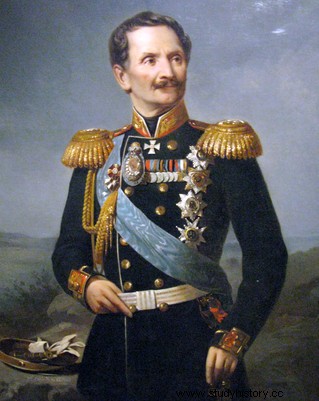
Fyodor Berg, the conspirators organized the attack on him.
The conspirators chose this building for a reason. First, it was on a route that Berg traveled frequently. Secondly, the tenement house could be bolted from the front, which gave a chance to escape. On September 19, 1863, eight assassins fired on and threw bombs and bottles with "hot liquid" on the governor's carriage. The effects, however, were meager.
Berg escaped the attack unscathed, and as soon as he cooled down a bit, he ordered the building to be razed to the ground with the help of cannons rolled into the courtyard. After a while he changed his mind, letting the Cossacks "clean up". They threw everything that was wrapped in their arm through the windows. They did not spare even the piano on which Fryderyk Chopin once played. This event was immortalized in his poem by Cyprian Kamil Norwid.
The bombers who were caught, then tried and executed were also sad. On this occasion, the son of Count Zamoyski - Stanisław. Moreover - as Stanisław Milewski writes in his book "Ciemne Sprawy interwar" - to additionally punish the head of the family:
the tenement house at Nowy Świat Street was taken over by the tsarist authorities shortly after the unsuccessful coup, for the purpose of "an eternal example and education for the rebellious population of Warsaw." There were signs "Kazionnyje Zdanje" on it and the military authorities took it over. There is also a Russian club […].
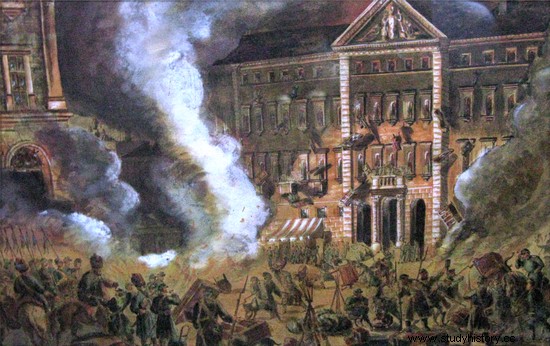
A painting by an unknown author depicting the Cossacks demolishing Andrzej Zamoyski's House of Interest after the unsuccessful attack on Berg.
Andrzej Zamoyski, while in exile, tried to regain his property, but it did not bring any results. This is how the next decades passed, until World War I broke out and the Russians finally left Warsaw. However, with the advent of independence, the tenement house did not go to the heirs of "Mr. Andrzej". The building was taken over by the Treasury and only the plaques on it had the Polish text "State House", and it still remained in the hands of the military.
Until the Germans occupied Warsaw, little could be done about it. However, Poland barely regained independence for the heirs of Count Andrzej Zamoyski turned to Józef Piłsudski - who was the Chief of State at that time - with a memorandum, demanding that the looted property be returned.
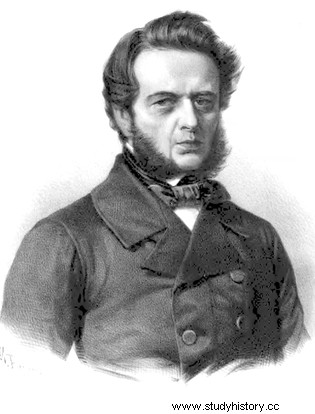
And here is Andrzej Countess. Zamoyski himself. A man who was definitely out of luck.
The power has changed, but the tenement house is not being returned
Piłsudski, however, had something else on his mind and referred the matter to the Ministry of Agriculture and State Goods. It was to decide whether, by any chance, the Zamoyski's claims were time-barred. Ministry officials also did not intend to decide on this matter and wrote back to the heirs that the settlement of this case would be suspended for the time being until the legislative Sejm adopts a resolution on confiscated property by partitions.
This, however, by no means satisfied the descendants of "Mr. Andrzej", who stated that the tenement house had not been formally confiscated, as no court proceedings were pending in this case. The Russians committed an ordinary robbery. This, in turn, did not convince the Ministry, which, in order to confirm its rights to the disputed building ... started its major renovation.
The case is put on the list
In this situation, the successors of Count Zamoyski, there was nothing else to do but to initiate a recovery action in court. They did so by submitting a relevant application to the District Court. This, in turn, prompted a sharp reaction from the press. The dailies - both left and right - unanimously stated that the behavior of the Zamoyski family is reprehensible, because the rich start their relations with the liberated homeland from litigation . Of course, this did not discourage the Zamoyski family from pursuing their claims. That's why the lawyers of both sides stepped in.
The case was a precedent because, as stated by the representative of the State Treasury, Franciszek Sprawliński:
Those dispossessed by the tsarist government are waiting for its settlement, to make claims against the Polish Treasury. And the Treasury would not be able to meet them, as it took over the estates burdened with debts and servits.
The lawyer also argued that the confiscation of the tenement house took place in accordance with the law in force at that time and that the decision of the Legislative Parliament should be waited for. On the other hand, the lawyers of the Zamoyski family obviously disagreed, arguing that the court should settle the dispute.
Ultimately, the District Court decided that the Treasury's mortgage entry was legal and dismissed the heirs' claims against the tenement house. S the heirs appealed to a higher instance, but in May 1921 the Court of Appeal also issued a judgment unfavorable to the Zamoyskis. In addition, he ordered them to pay court costs in the amount of 251,550 Polish marks. It was quite a significant amount if around 850 Polish marks were paid for the dollar in the middle of this month.
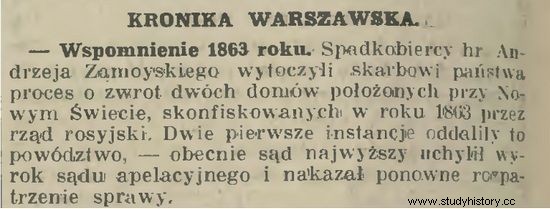
After long battles, it was only the Supreme Court on October 17, 1930 that shared the opinion of the Zamoyski family, referring the case to the Court of Appeal for re-examination. This was reported, inter alia, by Krakow's "Time"
After this verdict, it might seem that the case was closed, but that was not the case at all. Here is in 1930 . Zamoyski's attorneys appealed to the Supreme Court. As Stanisław Milewski writes:
was probably when they figured out that it was worth referring to the topmost instance. There has already been a ruling by the College of the Whole First Chamber [...], referring to property confiscated for participation in the January Uprising, which presented this problem in a very favorable light.
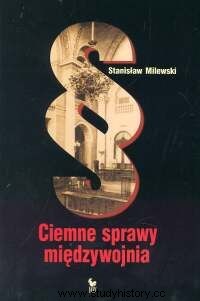
Happy End? Not really
This time the court, at a session on October 17, 1930, shared the plaintiffs' opinion, referring the case for reconsideration to the Court of Appeal. At the same time, the Seym finally passed in 1931 the long-awaited law on the restitution of property confiscated by the partitioning powers. It made it possible for eligible persons to recover family property confiscated after the November and January Uprisings. There was only a "little" catch. The heirs had to pay a tax, which in the case of high-value estates amounted to as much as 30 percent of their value! Do Andrzej's successors, Count. Has Zamoyski succeeded? According to Stanisław Milewski it is a questionable thing.
Complementary:
- "Time", 1921, 1930.
